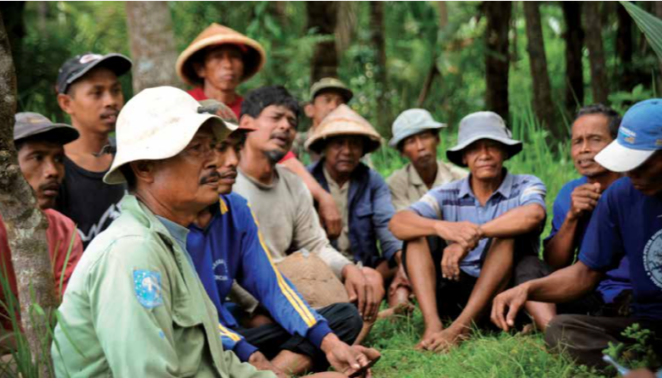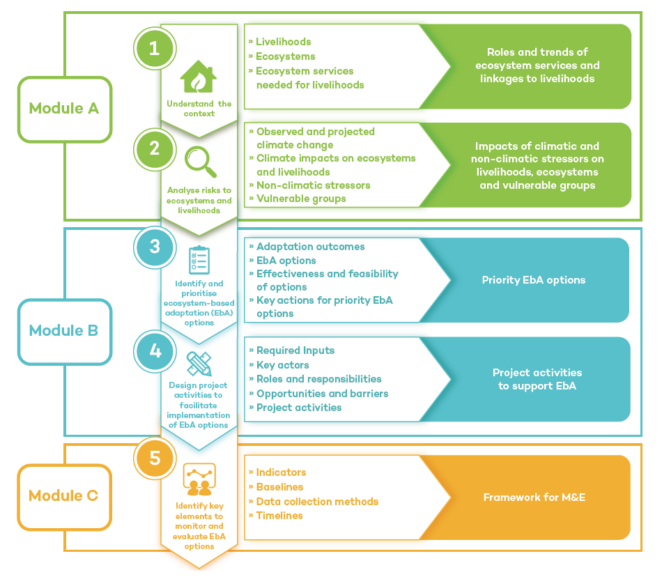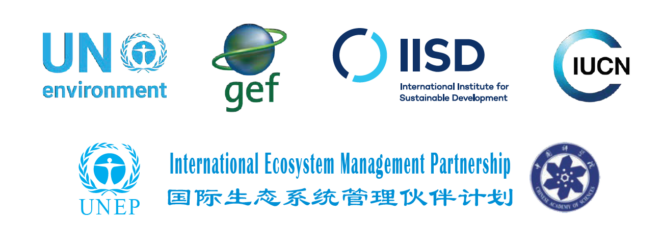ALivE – Adaptation, Livelihoods, and Ecosystems Planning Tool

Background
There’s an urgent need to prepare ecosystems for climate change impacts. Healthy ecosystems are critical for sustaining livelihoods. They also increase our capacity to adapt to climate change.
As more people recognize this need, an adaptation planning framework that emphasizes ecological health is critical. But what does Ecosystem-based Adaptation (EbA) look like in practice?
Often, EbA initiatives resemble more traditional conservation projects that may have positive ecological and socioeconomic benefits for adaptation. But with the urgent need to prepare people and ecosystems for climate change impacts, we need such projects to directly address climate risks and vulnerabilities and incorporate current and future climate information to the best of our ability.
This leads to the question: How can we equip people working in the fields of adaptation, conservation and development with the information and guidance they need to design, implement and monitor feasible and effective EbA options?
ALivE – Adaptation, Livelihoods and Ecosystems
IISD has been collaborating with the International Union for Conservation of Nature (IUCN) to explore these questions and to develop a planning tool to help practitioners find the answers they need. We are excited to present the result of this collaboration: ALivE – The Adaptation, Livelihoods and Ecosystem Planning Tool.

ALivE is a computer-based tool designed to support its users in organising and analysing information to plan effective EbA options within a broader EbA planning process. ALivE stands for Adaptation, Livelihoods and Ecosystems. It is a rapid qualitative assessment technique that can be applied in any ecosystem, enabling the user to:
- Understand and analyse linkages among ecosystems, livelihoods and climate change.
- Identify and prioritise EbA options for community and ecosystem resilience.
- Design project activities that facilitate implementation of priority EbA options.
- Identify key elements and indicators for a monitoring and evaluation (M&E) framework.
ALivE is organised into three modules and five steps that build on each other:
- In Module A, you will systematically analyse links among ecosystems, livelihoods and climate change, to better understand vulnerability to climate change and the role of ecosystems in adaptation.
- In Module B, you will identify and prioritise EbA options for community and ecosystem resilience and design project activities that facilitate implementation of priority EbA options.
- In Module C, you will identify key elements and indicators for a monitoring and evaluation framework
We recommend that users review and familiarize themselves with the user manual before launching the computer-based tool (available to download from the right-hand column). The user manual provides you with detailed guidance on applying ALivE as part of an EbA planning process. In addition to step-by-step instructions for using the tool itself, the manual provides a framework and methodologies for collecting and organising the information required to use ALivE, as well as guidance on identifying entry points for integrating EbA into policies and planning processes.

Who is ALivE for?
Expected users of ALivE include project managers and practitioners working at the local or community level designing or implementing an EbA intervention. The secondary audience consists of stakeholders in the EbA planning process, including community members, local authorities, NGOs and policy-makers. Users of the tool will work closely with these stakeholders.
How does ALivE contribute to more effective adaptation?
To successfully reduce vulnerability to climate change, EbA interventions need a systematic consideration of the complexity of socio-ecological systems and the implications of current and future climate risks and changes for livelihoods and for ecosystem health. ALivE helps users to understand how livelihoods, vulnerable groups and ecosystems are affected by climatic and non-climatic stressors to identify and prioritize effective and feasible EbA options.
Additionally, the tool walks practitioners through the process of designing project activities and elements of a monitoring and evaluation (M&E) framework to support implementation and monitoring of prioritized options, emphasizing the need for adaptive management. It incorporates recognized criteria for EbA effectiveness, which can be applied by non-experts. The tool can be applied in any type of ecosystem.
To find answers to more questions visit the ALivE page.
The development of the ALivE Planning Tool was funded by Ecosystem-based Adaptation through South-South Cooperation (EbA South). AlivE is now publicly available and can be downloaded for free.

Authors
Anika Terton and Angie Dazé (International Institute for Sustainable Development)
Acknowledgements
The authors would like to thank Dr. Hannah Reid, Charlotte Hicks, Mathias Bertram, Dr. Chao Fu, Tine Rossing, Dr. Camila Donatti, Monica Coll Besa, and Ali Raza Rizvi as well as the EbA South’s Technical Advisor team (Mr. Pierre Bégat, Dr. Robert Raw, Dr. Anthony Mills) and the Project Management Unit (Ms. Tatirose Vijitpan, Ms. Diwen Tan, and Ms. Silvia Cazzetta) for their help and support throughout this project and in the production of the ALivE tool and user manual.
(0) Comments
There is no content